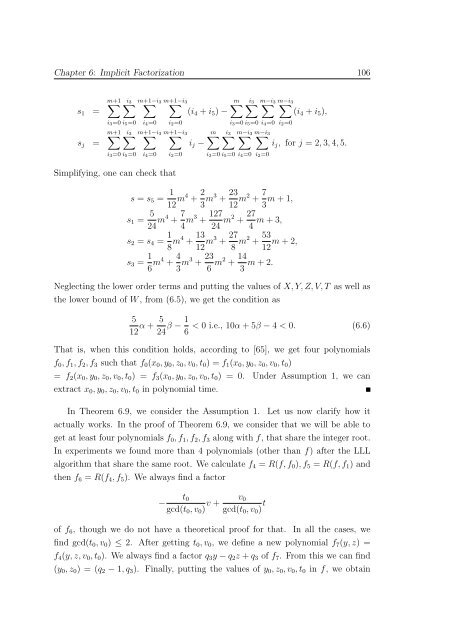Cryptanalysis of RSA Factorization - Library(ISI Kolkata) - Indian ...
Cryptanalysis of RSA Factorization - Library(ISI Kolkata) - Indian ...
Cryptanalysis of RSA Factorization - Library(ISI Kolkata) - Indian ...
Create successful ePaper yourself
Turn your PDF publications into a flip-book with our unique Google optimized e-Paper software.
Chapter 6: Implicit <strong>Factorization</strong> 106<br />
s 1 =<br />
s j =<br />
m+1<br />
∑<br />
i 3<br />
∑<br />
i 3 =0 i 5 =0<br />
m+1<br />
∑∑i 3<br />
i 3 =0 i 5 =0<br />
m+1−i<br />
∑ 3<br />
i 4 =0<br />
m+1−i<br />
∑ 3<br />
i 4 =0<br />
m+1−i<br />
∑ 3<br />
i 2 =0<br />
m+1−i<br />
∑ 3<br />
i 2 =0<br />
(i 4 +i 5 )−<br />
i j −<br />
m∑<br />
m∑<br />
i 3<br />
∑<br />
m−i<br />
∑ 3<br />
i 3 =0 i 5 =0 i 4 =0 i 2 =0<br />
∑i 3 m−i<br />
∑ 3 m−i<br />
∑ 3<br />
i 3 =0 i 5 =0 i 4 =0 i 2 =0<br />
m−i<br />
∑ 3<br />
(i 4 +i 5 ),<br />
i j , for j = 2,3,4,5.<br />
Simplifying, one can check that<br />
s = s 5 = 1<br />
12 m4 + 2 3 m3 + 23<br />
12 m2 + 7 3 m+1,<br />
s 1 = 5<br />
24 m4 + 7 4 m3 + 127<br />
24 m2 + 27<br />
4 m+3,<br />
s 2 = s 4 = 1 8 m4 + 13<br />
12 m3 + 27 8 m2 + 53<br />
12 m+2,<br />
s 3 = 1 6 m4 + 4 3 m3 + 23<br />
6 m2 + 14<br />
3 m+2.<br />
Neglecting the lower order terms and putting the values <strong>of</strong> X,Y,Z,V,T as well as<br />
the lower bound <strong>of</strong> W, from (6.5), we get the condition as<br />
5<br />
12 α+ 5<br />
24 β − 1 6<br />
< 0 i.e., 10α+5β −4 < 0. (6.6)<br />
That is, when this condition holds, according to [65], we get four polynomials<br />
f 0 ,f 1 ,f 2 ,f 3 such that f 0 (x 0 ,y 0 ,z 0 ,v 0 ,t 0 ) = f 1 (x 0 ,y 0 ,z 0 ,v 0 ,t 0 )<br />
= f 2 (x 0 ,y 0 ,z 0 ,v 0 ,t 0 ) = f 3 (x 0 ,y 0 ,z 0 ,v 0 ,t 0 ) = 0. Under Assumption 1, we can<br />
extract x 0 ,y 0 ,z 0 ,v 0 ,t 0 in polynomial time.<br />
In Theorem 6.9, we consider the Assumption 1. Let us now clarify how it<br />
actually works. In the pro<strong>of</strong> <strong>of</strong> Theorem 6.9, we consider that we will be able to<br />
get at least four polynomials f 0 ,f 1 ,f 2 ,f 3 along with f, that share the integer root.<br />
In experiments we found more than 4 polynomials (other than f) after the LLL<br />
algorithm that share the same root. We calculate f 4 = R(f,f 0 ),f 5 = R(f,f 1 ) and<br />
then f 6 = R(f 4 ,f 5 ). We always find a factor<br />
t 0<br />
−<br />
gcd(t 0 ,v 0 ) v + v 0<br />
gcd(t 0 ,v 0 ) t<br />
<strong>of</strong> f 6 , though we do not have a theoretical pro<strong>of</strong> for that. In all the cases, we<br />
find gcd(t 0 ,v 0 ) ≤ 2. After getting t 0 ,v 0 , we define a new polynomial f 7 (y,z) =<br />
f 4 (y,z,v 0 ,t 0 ). We always find a factor q 3 y−q 2 z +q 3 <strong>of</strong> f 7 . From this we can find<br />
(y 0 ,z 0 ) = (q 2 − 1,q 3 ). Finally, putting the values <strong>of</strong> y 0 ,z 0 ,v 0 ,t 0 in f, we obtain
















